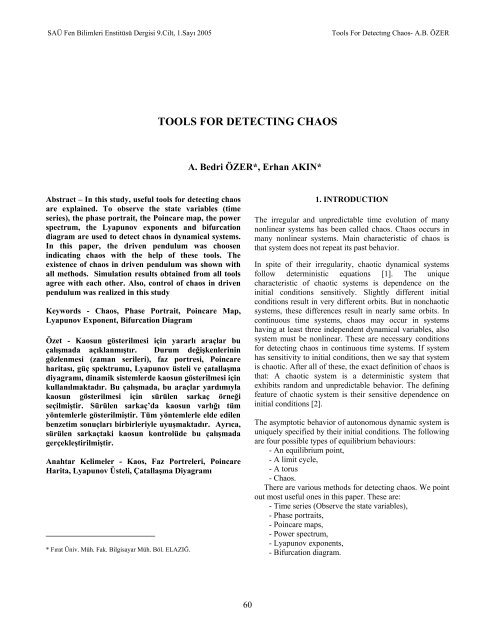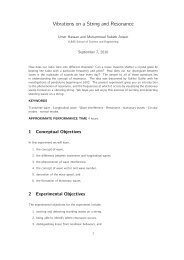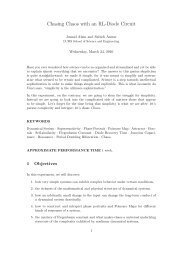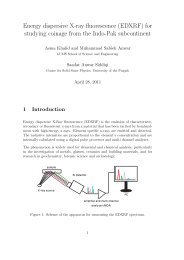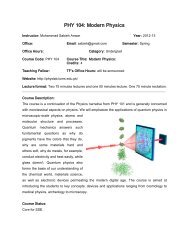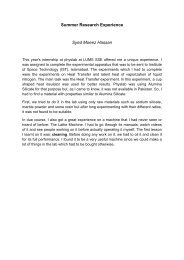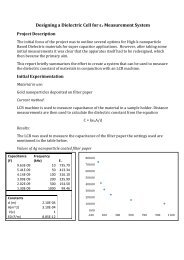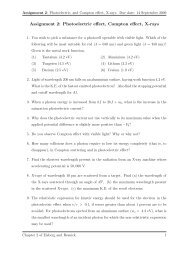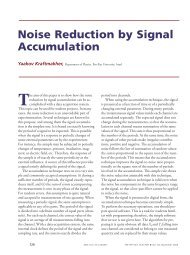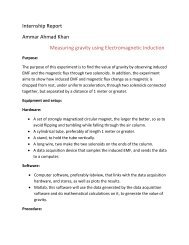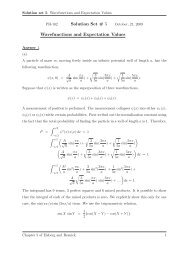Create successful ePaper yourself
Turn your PDF publications into a flip-book with our unique Google optimized e-Paper software.
SAÜ Fen Bilimleri Enstitüsü Dergisi 9.Cilt, 1.Sayõ 2005<strong>Tools</strong> For Detectõng Chaos- A.B. ÖZERTOOLS FOR DETECTING CHAOSA. Bedri ÖZER*, Erhan AKIN*Abstract – In this study, useful tools <strong>for</strong> <strong>detecting</strong> <strong>chaos</strong>are explained. To observe the state variables (timeseries), the phase portrait, the Poincare map, the powerspectrum, the Lyapunov exponents and bifurcationdiagram are used to detect <strong>chaos</strong> in dynamical systems.In this paper, the driven pendulum was choosenindicating <strong>chaos</strong> with the help of these tools. Theexistence of <strong>chaos</strong> in driven pendulum was shown withall methods. Simulation results obtained from all toolsagree with each other. Also, control of <strong>chaos</strong> in drivenpendulum was realized in this studyKeywords - Chaos, Phase Portrait, Poincare Map,Lyapunov Exponent, Bifurcation DiagramÖzet - Kaosun gösterilmesi için yararlõ araçlar buçalõşmada açõklanmõştõr. Durum değişkenleriningözlenmesi (zaman serileri), faz portresi, Poincareharitasõ, güç spektrumu, Lyapunov üsteli ve çatallaşmadiyagramõ, dinamik sistemlerde kaosun gösterilmesi içinkullanõlmaktadõr. Bu çalõşmada, bu araçlar yardõmõylakaosun gösterilmesi için sürülen sarkaç örneğiseçilmiştir. Sürülen sarkaç’da kaosun varlõğõ tümyöntemlerle gösterilmiştir. Tüm yöntemlerle elde edilenbenzetim sonuçlarõ birbirleriyle uyuşmaktadõr. Ayrõca,sürülen sarkaçtaki kaosun kontrolüde bu çalõşmadagerçekleştirilmiştir.Anahtar Kelimeler - Kaos, Faz Portreleri, PoincareHarita, Lyapunov Üsteli, Çatallaşma Diyagramõ___________________________* Fõrat Üniv. Müh. Fak. Bilgisayar Müh. Böl. ELAZIĞ.1. INTRODUCTIONThe irregular and unpredictable time evolution of manynonlinear systems has been called <strong>chaos</strong>. Chaos occurs inmany nonlinear systems. Main characteristic of <strong>chaos</strong> isthat system does not repeat its past behavior.In spite of their irregularity, chaotic dynamical systemsfollow deterministic equations [1]. The uniquecharacteristic of chaotic systems is dependence on theinitial conditions sensitively. Slightly different initialconditions result in very different orbits. But in nonchaoticsystems, these differences result in nearly same orbits. Incontinuous time systems, <strong>chaos</strong> may occur in systemshaving at least three independent dynamical variables, alsosystem must be nonlinear. These are necessary conditions<strong>for</strong> <strong>detecting</strong> <strong>chaos</strong> in continuous time systems. If systemhas sensitivity to initial conditions, then we say that systemis chaotic. After all of these, the exact definition of <strong>chaos</strong> isthat: A chaotic system is a deterministic system thatexhibits random and unpredictable behavior. The definingfeature of chaotic system is their sensitive dependence oninitial conditions [2].The asymptotic behavior of autonomous dynamic system isuniquely specified by their initial conditions. The followingare four possible types of equilibrium behaviours:- An equilibrium point,- A limit cycle,- A torus- Chaos.There are various methods <strong>for</strong> <strong>detecting</strong> <strong>chaos</strong>. We pointout most useful ones in this paper. These are:- Time series (Observe the state variables),- Phase portraits,- Poincare maps,- Power spectrum,- Lyapunov exponents,- Bifurcation diagram.60
SAÜ Fen Bilimleri Enstitüsü Dergisi 9.Cilt, 1.Sayõ 2005<strong>Tools</strong> For Detectõng Chaos- A.B. ÖZERThere are other methods <strong>for</strong> <strong>detecting</strong> <strong>chaos</strong> (Lyapunovdimension, correlation dimension, entropy and etc.) butthey are rarely used, because they are difficult <strong>for</strong> <strong>detecting</strong><strong>chaos</strong> in practical systems.Driven pendulum is a practical system <strong>for</strong> exploringnonlinear dynamics. First, Galileo noticed its characteristic.Since Galileo has discovered it, pendulum is appropriatesystem <strong>for</strong> investigate and teach nonlinear dynamics. So, itis useful <strong>for</strong> <strong>detecting</strong> <strong>chaos</strong>. Figure.1 shows a simplependulum.Control of chaotic systems is of current interest and severaltechniques have been proposed. One fundamental propertyof <strong>chaos</strong> is the occurrence of dense orbits. When a chaoticsystem is to be controlled, the periodic orbit is used suchthat the desired trajectory of the controlled system is givenas a periodic orbit of the chaotic system [3].In our research, tools <strong>for</strong> <strong>detecting</strong> <strong>chaos</strong> are given and wehave applied the Pyragas control method to a chaoticpendulum.We can split a second order differantial equation to twofirst order equation <strong>for</strong> solving with computational method(Equation 3.a and 3.b). ω is the angular velocity.Pendulum is a non autonomous system because of externaldriving <strong>for</strong>ce. In chaotic analysis, an nth-order nonautonomous system can always be converted into an(n+1)th-order autonomous system by appending an extrastate (Equation 3.c) [4]. The final equations are below:dωω= − − sin θ + gcosφdt qdθ= ωdtdφ= ωdtD(3.a)(3.b)(3.c)For various g values, pendulum exhibits differentbehaviors. For example at g=1, periodic behavior, g=1.4,period-2 behavior, and <strong>for</strong> g=1.2, chaotic behavior [1].3. TOOLSFigure.1 Simple Pendulum2. DRIVEN PENDULUMA driven damped pendulum is described by the equation:2d θ dθ2I + b + ω0I sin θ = T sin ωft(1)2dt dtwhere θ is position of pendulum, I is inertia torque, b isfriction parameter, ω 0 is resonance frequency, ω f isangular velocity of drive, T is magnitude torque of drive.For easiness, we need dimensionless equation [4]. Thedimensionless equation is:2d θ 1 dθ'+ + sin θ = g cos ω2 'Dt'dt q dt'where t 0 t ω I= ω , q 0 T= , gb= 2I, ω D = ωfω 0 .ω 0a. Time Series (Trajectory Plot)This method is easiest one and it is a visual method. Inthis method, the state variables of the system are observedand if they exhibit irregular or unpredictable behavior, thenit is called chaotic. Otherwise (fixed point, periodic andquasi periodic) it is called nonchaotic. Figure.2.a, 2.b and2.c show the time series of periodic, period-2 and chaoticbehaviors of pendulum respectively.b. Phase PortraitsPhase portarit is a two-dimensional projection of thephase-space [2]. It represents each of the state variable’sinstantaneous state to each other. For pendulum example,angular velocity-position graph is a phase portrait. Chaoticand other motions can be distinguished visually from eachother according to the Table.1. A fixed point solution is apoint in a phase portrait. A periodic solution is a closedcurve in phase portrait. Chaotic solutions are distinctcurves in phase portrait. Periodic and chaotic phase portraitexamples are shown in Figure 3. Figure 3.a shows periodicbehavior, Figure 3.b shows chaotic behavior.(2) Table.1 Solutions of dynamic systems (Phase Portrait)Solution Fixed Periodic QuasiPeriodicPhase Point Closed TorusportraitcurveChaosDistinctshapes61
SAÜ Fen Bilimleri Enstitüsü Dergisi 9.Cilt, 1.Sayõ 2005<strong>Tools</strong> For Detectõng Chaos- A.B. ÖZERTime series of Chaotic Behavior (g=1.2)c. Poincare MapsAnother method is the Poincare map. The basic is thatn th -order continuous time system is replaced with (n-1) th -order map. It is constructed by sampling the phase portraitstroboscopically. Its aim is to simplify the complicatedsystems, and it is useful <strong>for</strong> stability analysis [5]. Chaoticand other motions can be distinguished visually from eachother according to the Table.2. Periodic behavior is a fixedpoint in Poincare map. A quasi periodic behavior is closedcurve or points in Poincare maps. Distinct set of pointsindicate the <strong>chaos</strong> in Poincare map. In practice, onechooses an (n-1) dimensional Poincare surface Σ, whichdivides R n into two regions. If Σ is choosen properly, thenthe trajectory under observation will repeatedly passthrough Σ. The set of these crossing points is a Poincaremap. Figure 4 shows the basic idea of Poincare Map. Figure5.a and 5.b show the Poincare map of periodic and chaoticbehavior, respectively.Angular Velocity (Rad/sn)21.510.50-0.5-1-1.5-2-2.50 200 400 600 800 1000Tim e(c)Figure. 2 Time series of a state variable (angular velocity) of pendulum(a) periodic behavior (g=1), (b) period-2 behavior (g=1.4), (c) chaoticbehavior (g=1.2).2.521.5Phase Portrait of Periodic Behavior (g=1)Table.2 Solutions of dynamic systems (Poincare Maps)Solution Fixed Periodic QuasiPeriodicPoincare - Point ClosedMapsCurveChaosDistinctpointsAngular Velocity (Rad/sn)10.50-0.5-12Time series of Periodic Behavior (g=1)-1.5-2Angular Velocity (Rad/sn)1.510.50-0.5-1-1.5-21100 200 300 400 500 600 700Time(a)Time series of Period-2 Behavior (g=1.4)-2.5-3 -2 -1 0 1 2 3PositionAngular Velocity (Rad/sn)2.521.510.50-0.5-1-1.5(a)Phase Portrait of Chaotic Behavior (g=1.2)0.5-2Angular Velocity (Rad/sn)0-0.5-1-1.5-2.5-35 -30 -25 -20 -15 -10Position(b)Figure 3. Phase portraits of pendulum (Angular velocity-position) (a)periodic behavior (g=1) (b) chaotic behavior (g=1.2).-20 100 200 300 400 500 600Time(b)62
SAÜ Fen Bilimleri Enstitüsü Dergisi 9.Cilt, 1.Sayõ 2005<strong>Tools</strong> For Detectõng Chaos- A.B. ÖZERspectrum of periodic behavior and chaotic behavior,respectively. If the behavior is chaotic, then power spectraof system is expressed in terms of oscillations with acontinuum of frequencies.e. Lyapunov ExponentsAngular velocityAngular Velocity-1.5-2-2.5-3-3.5Figure. 4 Basic of Poincare MapPoincare Section of Periodic Behavior (g=1)-4-1 -0.5 0 0.5 1 1.5Position100-10-20-30-40(a)Poincare Section of Chaotic Behavior (g=1.2)The Lyapunov exponents ( λ i i=1,2,..n) are the numbersthat measure the exponential attraction or separation in timeof two adjacent orbits in the phase space with close initialconditions. n dimensional system has n Lyapunovexponents. If original system is non autonomous as <strong>for</strong>cedpendulum, one Lyapunov exponent is zero. If the systemhas at least one positive Lyapunov exponent, it indicates the<strong>chaos</strong>. If the largest Lyapunov exponent is negative then theorbits converge in time and system is insensitive to initialconditions. If it is positive, then the distance betweenadjacent orbits grows exponentially and system exhibitssensitive dependence on initial conditions, so it is chaoticwe say. Main idea of Lyapunov exponent is below:Suppose x is a point at time t , and consider a nearby point,say x + δ , where δ is a tiny separation vector of initiallength. In numerical studies, one Lyapunov finds asδ = δ 0 e λt . If λ > 0 , neighboring trajectories separateexponentially rapid. So positive λ indicates the sensitivityto initial conditions.Assume an initial condition x 0 is chosen arbitrarily. TheLyapunov exponents are1λ i = limt→∞ln mi( t)(4)ti = 1,2,...,nand m be the eigenvalues of Jacobian matrix ofsystem [5].Lyapunov exponents of pendulum <strong>for</strong> periodic andchaotic behaviors are shown in Figure. 6.a and 6.brespectively. The pendulum is 3rd-order so, it has threeexponents. One of them is zero because of equation 3.c. asseen. In Figure 7.a system is periodic, so exponents arenegative. But in Figure 7.b one exponent is positive, so it ischaotic [Matlab/LET Toolbox] [6].-50-2 -1.5 -1 -0.5 0 0.5 1 1.5 2Position(b)Figure. 5 Poincare maps of pendulum (Angular velocity-Position) (a)periodic behavior (g=1), (b) chaotic behavior (g=1.2).d. Power SpectrumChaotic signals are wideband signals, so they can beeasily distinguished from periodic signals by looking attheir frequency spectra. Figure 6.a and 6.b show the power63
SAÜ Fen Bilimleri Enstitüsü Dergisi 9.Cilt, 1.Sayõ 2005<strong>Tools</strong> For Detectõng Chaos- A.B. ÖZERPower Spectrum of Periodic Behavior (g=1)45Power Spectrum of Angular Velocity4035302520151052 4 6 8 10 12 14 16 18 20Frequency(a)Power Spectrum of Chaotic Behavior (g=1.2)250(a)Power Spectrum of Angular Velocity2001501005000 5 10 15 20 25 30 35 40 45Frequency(b)Figure. 6 Power spectrum of pendulum (Angular velocity) (a) periodicbehavior (g=1), (b) chaotic behavior (g=1.2).f. Bifurcation Diagram (b)Figure. 7 Lyapunov exponents of pendulum <strong>for</strong> (a) periodic behaviorPhase portraits, Poincare maps, time series, power spectrum(g=1), (b) chaotic behavior (g=1.2)and lyapunov exponents provide in<strong>for</strong>mation about thedynamics of the pendulum <strong>for</strong> specific values of theFor the pendulum, bifurcations can be easily detected byparameters ( g , q , ωD). The dynamics may also beviewed more globally over a range of parameter values,thereby allowing simultaneous comparison of periodic andchaotic behavior. For some values of the parameters, apendulum will have only one long term motion, while <strong>for</strong>other slightly different choices; two or more motions maybe possible. If several of them are stable, the actualbehavior will be depending on initial conditions. Indifferential equations, if a change in the number of solutionis depending on parameter variation, it is called bifurcation[1].examining a graph of ω versus the drive amplitude .Several examples of these graphs called bifurcationdiagrams. A bifurcation diagram of pendulum is shown inFigure. 8 [7]. As shown in Figure.8, the interval [ 0,9− 1]in horizontal axis (g), exhibits periodic behavior, intervals[ 1 − 1.1]and [ 1.3− 1.4]exhibit period-2 behavior, andintervals [ 1.13− 1.3]and [ 1.7− 1. 8]exhibit chaoticbehavior.4. CONTROL OF CHAOS IN DRIVENPENDULULUMControl of <strong>chaos</strong> is an important task <strong>for</strong> scientist. Thereare a few methods <strong>for</strong> <strong>chaos</strong> control: OGY method, Pyragasmethods (two methods), taming <strong>chaos</strong> method and etc. [3]Pyragas methods use continuous time feedback [8]. Theblock diagrams of these methods are shown in Fig.9.g64
SAÜ Fen Bilimleri Enstitüsü Dergisi 9.Cilt, 1.Sayõ 2005<strong>Tools</strong> For Detectõng Chaos- A.B. ÖZERFigure. 8 Bifurcation diagram of pendulum(a)(a)(b)Figure. 9 Block diagram of Pyragas methods.In this study, Pyragas control method (second one) isapplied to chaotic pendulum (g=1.2). Chaotic behaviour ofpendulum is shown in Figure 10.a. After control, behaviourof controlled pendulum is shown in Figure 10.b5. CONCLUSIONSA non autonomous dynamical system (driven pendulum)has been simulated by MATLAB. Driven pendulum hasdifferent behaviours, when g=1, driven pendulum exhibitsperiodic behavior, and at g=1.2 it exhibits chaotic behavior.So, tools <strong>for</strong> <strong>detecting</strong> <strong>chaos</strong> are used in this system. Allthese results of methods are in full agreement and confirmthe correctness of these methods. Also, control of <strong>chaos</strong>was implemented in this study.(b)Figure. 10 Behaviour of chaotic pendulum (g=1.2) (a)- Be<strong>for</strong>e control (b)-After control6. REFERENCES[1] Baker, G. L., Gollub, J. P.,. Chaotic Dynamics anIntroduction, Cambridge University Press, 1990.[2]Giannakopoulos, K., Deliyannis, T.,Hadjidemetriou, J.,. Means <strong>for</strong> Detecting Chaos andHyper<strong>chaos</strong> in Nonlinear Electronic Circuits,. DSP2., 951 – 954, 2002.[3] Castillo, O., Melin, P.,. Soft Computing <strong>for</strong> Controlof Non-linear Dynamical Systems, Physica-Verlag,2001.[4] Strogatz, S. H.,. Nonlinear Dynamics and Chaos:with Applications to Physics, Biology, Chemistry, andEngineering, Cambridge Press, 1994.[5] Parker, T. S., Chua, L. O.,. Practical NumericalAlgorithms <strong>for</strong> Chaotic Systems, Springer-Verlag,World Publishing Corp. 1989.65
SAÜ Fen Bilimleri Enstitüsü Dergisi 9.Cilt, 1.Sayõ 2005<strong>Tools</strong> For Detectõng Chaos- A.B. ÖZER[6] Siu, S. W. K,. Lyapunov Exponent Toolbox,ftp://ftp.mathworks.com/pub/contrib/v5/misc/let, 1998.[7] Walter, J. M.,. The nonlinear Pendulum Project:PHSI362 project, University Of Ogata, 1998.[8] Pyragas, K., Continuous Control of Chaos by Self-Controlling Feedback, Physics Letter A, 199266


